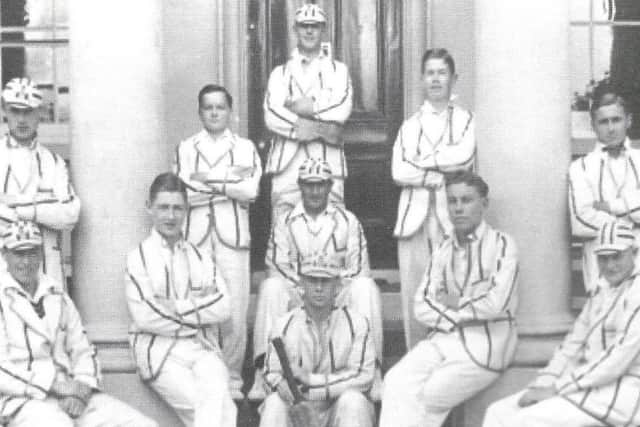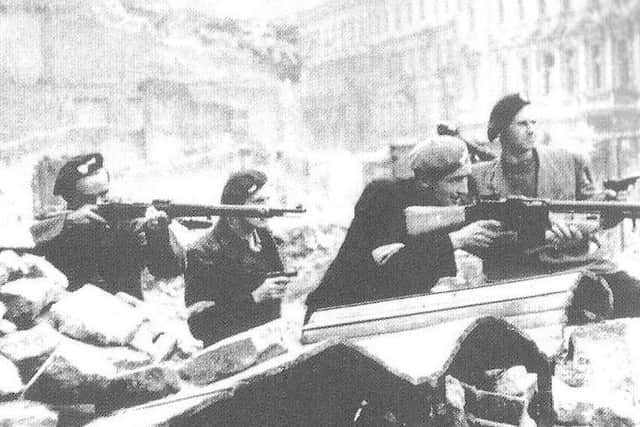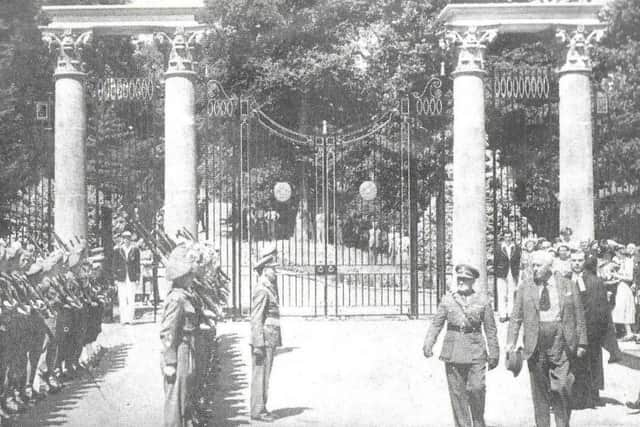Book about County Fermanagh school’s role in Second World War


All too often the stories of going to war didn’t include a homecoming.
With another Remembrance Day just over, a recently published book entitled ‘Portora and Portorans in the Second Great War’ filled Roamer’s page on Wednesday, with an assurance of more today.
Advertisement
Hide AdAdvertisement
Hide AdCo-written by old-Portorans Robert Northridge (a pupil from 1955-62 and a teacher from 1973-2010) and Clive Johnston (a pupil from 1959-66) it was launched last week by Robert (Clive was in London) in the historic school’s Steele Hall.


Robert has already published a book about Portora’s part in WWI and for this latest volume he and Clive researched the school’s registers, student magazines, WWII lists and honours boards.
They asked families, friends and relatives of former teaching staff and pupils for war records, letters, diaries and photographs.
The book contains nearly 200 pages of wartime accounts, statistics and analysis and just a small fraction of the content was outlined on Wednesday’s page.
Advertisement
Hide AdAdvertisement
Hide AdThere are several more accounts here today drawn from around 100 of the book’s pages devoted to biographies of the Portorans who survived WWII, of all those who died, and of the staff members who served. A total of 456 went to war and 50 died.


At the launch of the book last week Robert Northridge spoke about just a few stories, summaries and observations from the book which are the basis of today’s Roamer page.
In his poignant analysis of members of the school’s sports teams who served Robert noted - “the peer pressure to join up on a closely knit group such as a Rugby XV must have been very great.”
For instance, 18 boys out of 22 (including reserves and substitutes) from the school’s 1938-39 senior rugby team later went to war and four died.
Advertisement
Hide AdAdvertisement
Hide AdFrom the following year’s senior team in 1939-40, once again 18 served, out of a total of 23 players. Three died, one of them


Oliver Duncan who won the Ulster Schools’ Cup in 1940, 1941 and 1942.
Brothers Derek and Geoffrey Reay, both killed while serving with the RAF and commemorated by the school’s Reay Memorial gates, were members of the 1938-39 and 1939-40 teams consecutively.
During his speech at the book-launch Mr Northridge outlined the brothers’ final missions. In one of 16 massed night attacks on Berlin during a period of three months, 400 Allied bombers unleashed a devastating deluge of bombs on the city on 23 November 1943.
Advertisement
Hide AdAdvertisement
Hide AdFlight Lieutenant Derek Reay was piloting a 207 Squadron Lancaster bomber accompanied by six crewmen.
“They failed to return from the mission and it was presumed they had been shot down. Their bodies were never found.”
Almost a year later on 4 November 1944, in an even larger massed night attack on the industrial Rhineland city of Bochum, Flying Officer Geoffrey Reay and all the crew of his Halifax bomber died, shot down near their target. It was one of 28 aircraft lost from 749 Allied bombers on the mission.
Robert Northridge highlighted two other team sports where Portora boys played together and signed up together.
Advertisement
Hide AdAdvertisement
Hide Ad“From the cricket teams, in four years ten cricket players from the 1st XI served their country and from the rowing IVs of 1931 and 1938, the whole crew, including the cox, signed up.”
The well-worn saying that truth is often stranger than fiction was very well illustrated at the book-launch with Robert’s account of Polish-born pupil Julian Eugeniusz Kulski.
And truth, it seems, can also be much harder to discover than fiction!
Though translated autobiographies have been published around the world, Robert could find no mention in school records of Julian Kulski’s heroism as a Polish resistance fighter!
Advertisement
Hide AdAdvertisement
Hide AdHe was born in Warsaw on 3 March 1929 and was at Portora from January 1946 to July 1947.
He rowed with the 1st IV and was a school boxing champion. His academic skills secured further qualifications at Oxford University and Yale.
During WWII he was a resistance fighter codenamed ‘Chojniacki’ in the Warsaw Uprising, for which he was decorated with the Medal for Bravery and the Silver Cross for Bravery and Valour.
Whist Julian’s sporting and academic accomplishments were in Portora’s files, none of his remarkable resistance work was recorded.
Advertisement
Hide AdAdvertisement
Hide AdWartime listings and military records were started when Portorans signed up for war but when Julian came to Portora his resistance work was done and dusted, a full five years previously.
His father, the wartime Mayor of Warsaw, secretly cooperated with the Polish underground against the German occupation and son Julian became a resistance fighter at only 12 years old.
The young lad was wounded twice in underground missions and attacks on the Germans and when the Warsaw Uprising collapsed Julian was put into a German POW camp.
After liberation by the Americans in May 1945, Julian came to Britain, a journey that was in itself another hair-raising tale. In 1946, aged 17, he joined Portora’s fifth form.
For further information about ‘Portora and Portorans in the Second Great War’ contact Roamer who’ll happily forward your details to the authors.